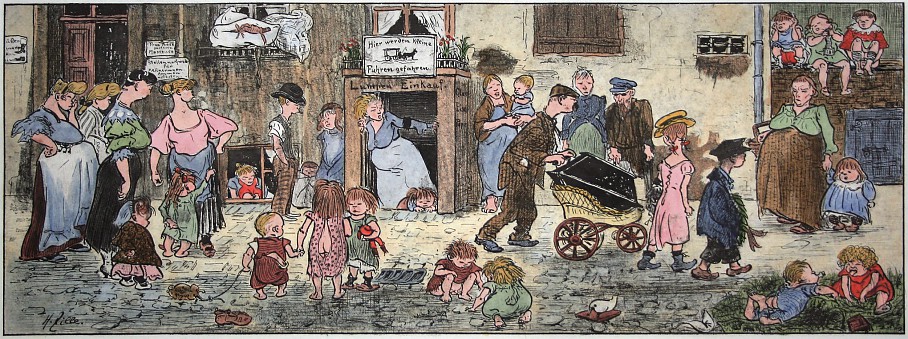"To Mother Earth"
A Child's Funeral in Berlin Milljöh
Heinrich Zille "To Mother Earth", 1905
color etching; 43 x 69 cm
"Do not get drunk! And bring the coffin back." – This is the saying under the color etching "To Mother Earth". This print, part of the series "Dark Berlin" published in 1905, is by Heinrich Zille (1858-1929). Some will certainly recognize it at once by the color and drawing stroke. The image shows a street scene from the proletarian "lower class" of Berlin, as it was captured by Heinrich Zille again and again – in drawings and lithographs.

Their everyday life in backyards, run-down tenements and dives, on streets and alleys formed his artistic subject. On the one hand, this probably had local patriotic reasons, because Zille himself also grew up in poor conditions in Berlin. On the other hand, he may have captured people and life there again and again, because the image offered him a good medium for social criticism. Thus, his drawings seem at first glance to be of great comedy, but usually turn out – often in connection with associated comments – as images of great tragedy. They show the viewer the miserable living, housing, and working conditions of the proletariat and other social fringe groups. It is no different with the graphic sheet presented here. A "lonely funeral procession" is shown, in which a child's coffin on a baby carriage is being pushed along a street in the middle of the "Milljöh" by a man, presumably the father of the deceased child. Although the eyes of many people rest on this funeral procession, it does not seem important enough for many more people to join it. This indifference may be a reference to the high mortality rate in Germany at that time – especially among children. As a result, people probably encountered such scenes with a sense of numbness and indifference. At least, the depiction gives this impression. At that time, people in higher social classes still died quite early, but the danger of contracting a life-threatening disease and dying an early death was disproportionately greater in the lower social classes due to the precarious living and housing situation. This is additionally alluded to in the commentary below the street scene. The sentence quoted at the beginning is probably the exclamation of a not clearly identifiable person, who reminds of highest haste with the removal of the child's corpse, since the coffin ("Sarj") would be needed again the next day. Conclusion: Time and money are so scarce that a dignified burial of one's own child seems almost impossible - not even a coffin of one's own is "possible". The viewers are left with the feeling of a hopeless tristesse. The many macabre and sarcastic elements give it a particularly strong impact.
The sheet "To Mother Eearth" was published in an edition of 100 copies, whereby there is one copy that differs from the others in one detail. This detail consists in the addition of a small crown placed on the child's coffin. It is a crown for the dead, which Zille must have added later and with which he further intensifies the irony of the scene. For if the money is not even enough for the coffin of one's own child, why should it be enough for a death crown? At the same time, however, this expresses in a sarcastic and macabre way the brief moment of consolation that one cannot belong to the "winners" in life, but at least in death: the crown emblazoned on the coffin shows it more than clearly to all bystanders as well as to the viewers.
Arbeitsgemeinschaft Friedhof und Denkmal e.V.
Zentralinstitut für Sepulkralkultur
Museum für Sepulkralkultur
Weinbergstraße 25–27
D-34117 Kassel | Germany
Tel. +49 (0)561 918 93-0
info@sepulkralmuseum.de








